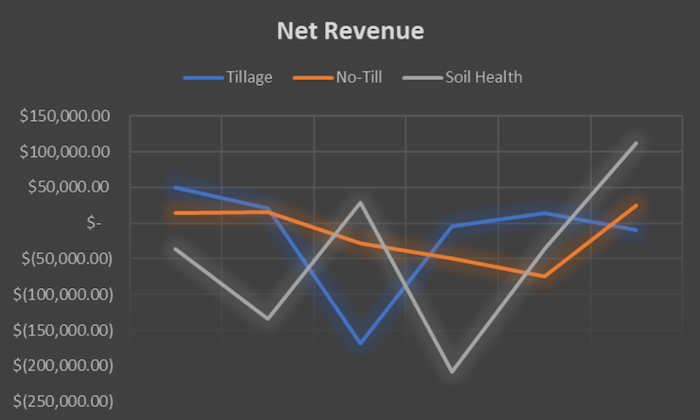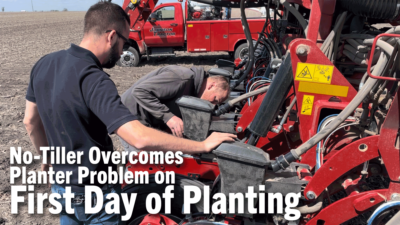A Colorado no-tiller’s 30-year assessment of his farm’s operating expenses when using tillage, no-till and no-till with additional soil health practices revealed a surprising result about what method of farming is most profitable.
But in reality, Roy Pfaltzgraff says the true costs of the three farming methods are not as straightforward as they seem.
Data-Intensive Assessment
Pfaltzgraff farms 2,200 dryland acres in Haxtun, Colo., an area with less than 14 inches of average annual rainfall. Since he returned to the farm in 2016, Pfaltzgraff changed the operation’s focus to soil health and now raises 12 or more different crops each year.
At the 2024 National No-Tillage Conference, Pfaltzgraff showed attendees a side-by-side comparison of the 30-year ROI of the three systems that had been in place on his family’s operation since 1991: tillage done in 1991-96, no-till with fallow from 2011-16 and no-till with soil health focus in 2017-22.
“This is outside my comfort zone,” Pfaltzgraff says. “I love talking about what I'm doing on the farm. Finances, I don't know a single farmer that's actually comfortable that talks about finances.”
Tillage Proves Profitable?
Here’s the original assessment that Pfaltzgraff came up with using projections for the 30 years of farming. He says surprisingly, tillage came out on top.

This chart shows Roy Pfaltzgraff’s initial comparison of his farm’s revenue had he been using tillage, no-till with fallow and no-till with soil health practices over the last 30 years. Surprisingly, tillage would have been the most profitable practice over the last 3 decades — that is, until Pfaltzgraff started asking questions about the numbers.
“Just quick and dirty looking at our books, it's time to go hook up the plow, fellas, because this is what my books are telling me,” Pfaltzgraff says. “When I looked at this, I was like this does not make sense. This does not reflect what I'm seeing. Then I had to start asking questions. The hardest thing to do is to learn how to ask questions and how to ask the right questions.”
Upon inspection, he noticed his fertilizer cost in 2012 was within $100 of his fertilizer cost in 2018, a year when fertilizer cost 4 times higher than average, he says. The operation also has 2 full-time employees currently, which Pfaltzgraff says is a first in the farm’s history and adds to the expenses.
“Suddenly I realized I can't look at dollars,” Pfaltzgraff says. “If we just want to believe the numbers, we should be farming with a steam engine because these guys were way more profitable per acre than we were. But sometimes we have to ask why this doesn't quite feel right.”
Highest Costs Per Acre
Next, Pfaltzgraff analyzed his top expenses during 6-year periods of each method of farming. When the operation was using tillage, 60% of the cost was interest, repairs, fuel, insurance, fertilizer, seed and herbicides. Herbicides were necessary because they were no-tilling spring crops but using tillage for fallow periods.
In the years when they were using only no-till, 60% of costs went to rent, fuel, insurance, fertilizer, herbicide, seed and agronomy. For the no-till with a soil health focus in later years, the biggest costs were rent, repairs, labor, fertilizer, insurance, seed and agronomy.
“A lot of those categories are actually the same,” Pfaltzgraff says. “Our agronomy cost in 1991 was $275. It was the cost of the soil test that we did that year. Our agronomy costs now is $20,000 a year at $10 an acre on 2,000 acres.
“These are how things have changed. We can't sit back and look at our books from ’90 and say, ‘Boy, we were a whole lot better off in these other methods.’ We actually have to get in there and we have to look at these details.”
In the coming months, No-Till Farmer will publish more data from Pfaltzgraff’s financial assessment, including how soil health practices faired when he assessed gross revenue and net revenue for the three methods of farming. Subscribe to No-Till Farmer magazine and sign up for our free daily email newsletter for the latest updates.
Related Content
No-Tiller Grows 18 Crops in 1 Year to Improve Soil Health
Continuous Cropping Retains Moisture While Improving Profitability
No-Till Networking & Knowledge at 2024 National No-Tillage Conference








Post a comment
Report Abusive Comment